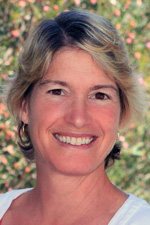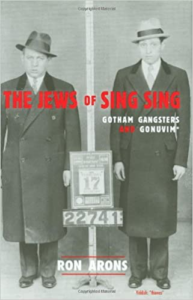“The Jews of Sing Sing,” by Ron Arons; Barricade Books, 2008; ISBN 978-1569803332; 384 pages.
By Eva Trieger

SOLANA BEACH, California — Back in 1965, I remember sitting on the stoop of the bungalow in Far Rockaway, and hearing my Pop Pop and his brothers-in-law kibitzing about the gonif who broke into his butcher shop and locked him and my Nana in the deep freeze. This left an indelible impression on me and my fascination with the underworld lingered and intensified. Apparently, I was not the only one for whom the dark side exerted its magnetic force. Former marketing executive in the software industry, Ron Arons, became a genealogical wizard tracking down his own great-grandfather’s checkered past.
When Arons learned that his great-grandfather was reported to have been born in three different places, he started the decade-long quest that would lead him to write The Jews of Sing Sing. Having lost his parents and grandparents at a young age, Arons put his sleuthing skills to work, and in the unlikely Latter Day Saints Family History Library in downtown Salt Lake City, hit pay dirt! Digging deeper into these identities, Arons unearthed some rather shocking news. His great-grandfather had emigrated to the United States, and married two women, concurrently. This breach of justice landed him a three-year sentence for bigamy in Ossining, New York.
By piecing together various accounts and comparing wedding dates and birth dates, Arons discovered that Isaac Spier’s birth certificates recorded him as a native of London, England, Hanley, England or New York. Further research revealed the whereabouts of Spier’s residences in various New York boroughs, as well as his wives’ and children’s names.

Arons continued to investigate not only his own family tree but also delved into the complex characters of other notorious Jewish gangsters who had spent time behind bars at Sing Sing prison. His book is cleverly constructed in chapters devoted to criminals and each page is jam-packed with facts and fascinating details about the gangsters and their connections to each other. Some of the names will be familiar to the reader, such as Bugsy Seigel and Meyer Lansky, while others may be less well-known. New to me were Benny Fein, Monk Eastman, and Irving Wexler.
One particular chapter that I found shocking related the tale of Isidore Fishbein and his preeminent role in promoting Jewish prostitution. I was wholly unaware of this activity because, typically, Jews are taught that we are made in the image of G-d and therefore to defile the body goes against every tenet. Arons reveals statistics of Jewish brothels and “clandestine houses” in the Ukraine, Warsaw, and Vienna. Brothels were big money-makers and New York’s Lower East Side sponsored more than its fair share of houses of ill repute, and this sparked some antisemitic response.
Some excellent chapters in the book deal with Arons’ visit to Sing Sing. He invoked the name of my rabbi! (Irving Koslowe), a man well-respected and known to the Sing Sing officials for his work with Jewish inmates, including Julius and Ethel Rosenberg. The author felt this connection helped him gain access to the prison. Once inside the prison, Arons described the cell block and how it didn’t square with his prior research about cells based on earlier inmates’ reports. A 42-inch television screen afforded the prisoners access to media on a pretty luxurious level! Enchanting was Arons description of how he was asked to join a Sukkoth service in the Jewish chapel at the prison. Participating in a mitzvah, he could hardly pass up the opportunity to shake a lulav and hold the esrog! Funnier still was that when asked, Arons told me that he questioned some of the other members of the minyan’s authenticity. The author told me, “I knew that the leader of the “minyan” was a two-time sex offender, so I did not have much affection for him. There were others in the chapel who clearly were not Jewish but claimed to be so in order to get kosher meals and privileges.”
The Jews of Sing Sing provides a great deal of insight about the Jews who came to America at the end of the 19th century and gained a toehold in society in America. While not every Jew who arrived on American soil was a stellar individual, those who fell into crime may have had some compelling reasons for seeking a sustainable life. Ron Arons’ book provides a fabulous backdrop for understanding why some Jews succumbed to a life of crime, and hopefully, the author achieved some closure in learning about his own great-grandpa.
The Jews of Sing Sing is available on Amazon.com and BarnesandNoble.com.
*
Eva Trieger is a Solana Beach-based freelance writer who specializes in coverage of the arts. She may be contacted via eva.trieger@sdjewishworld.com